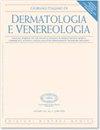意大利经典医源性卡波西肉瘤的诊断和治疗指南。
IF 2
Q3 Medicine
Giornale Italiano Di Dermatologia E Venereologia
Pub Date : 2020-11-12
DOI:10.23736/S0392-0488.20.06703-6
引用次数: 2
摘要
卡波西肉瘤(KS)是一种与人类疱疹病毒8 (HHV8)感染相关的淋巴管增生性疾病。四种临床亚型是公认的:经典,地方病,流行病(艾滋病毒相关)和医源性。KS的诊断是基于临床特征、组织病理学评估和HHV8血清学。典型的KS通常局限于皮肤,病程为慢性,而医源性变异可能表现为粘膜、淋巴结或内脏受累。临床分期是指导治疗的基础。局部疾病可以用不同的局部疗法治疗,即使没有比较这些不同方式的随机试验。侵袭性、播散性KS和累及内脏的病例通常需要全身化疗,最常见的是长春花碱、博来霉素或紫杉醇。医源性KS需要免疫抑制逐渐减少/停药,如果可能的话,移植后KS改用m-TOR抑制剂。意大利专家小组目前的工作提供了基于文献的批判性审查和长期广泛的个人经验的KS诊断和管理指南。本文章由计算机程序翻译,如有差异,请以英文原文为准。
Italian guidelines for the diagnosis and treatment of classic and iatrogenic Kaposi's sarcoma.
Kaposi's sarcoma (KS) is a lymphangioproliferative disorder associated with human herpesvirus 8 (HHV8) infection. Four clinical subtypes are recognized: classic, endemic, epidemic (HIV-related) and iatrogenic. KS diagnosis is based on clinical features, histopathological assessment, and HHV8 serology. Classic KS is usually skin-limited and has a chronic course, while the iatrogenic variant may show mucosal, nodal or visceral involvement. Clinical staging is fundamental to guide the management. Localized disease may be treated with different local therapies, even if there are no randomized trials comparing these different modalities. Aggressive, disseminated KS and cases with visceral involvement usually require systemic chemotherapy, most commonly vinblastine, bleomycin or paclitaxel. Iatrogenic KS needs immunosuppression tapering/withdrawal and, if possible, switch to m-TOR inhibitors in post-transplant KS. The present work by a panel of Italian experts provides guidelines on KS diagnosis and management based on a critical review of the literature and a long and extensive personal experience.
求助全文
通过发布文献求助,成功后即可免费获取论文全文。
去求助
来源期刊

Giornale Italiano Di Dermatologia E Venereologia
DERMATOLOGY-
CiteScore
1.90
自引率
0.00%
发文量
0
审稿时长
6-12 weeks
期刊介绍:
The journal Giornale Italiano di Dermatologia e Venereologia publishes scientific papers on dermatology and sexually transmitted diseases. Manuscripts may be submitted in the form of editorials, original articles, review articles, case reports, therapeutical notes, special articles and letters to the Editor.
Manuscripts are expected to comply with the instructions to authors which conform to the Uniform Requirements for Manuscripts Submitted to Biomedical Editors by the International Committee of Medical Journal Editors (www.icmje.org). Articles not conforming to international standards will not be considered for acceptance.
 求助内容:
求助内容: 应助结果提醒方式:
应助结果提醒方式:


